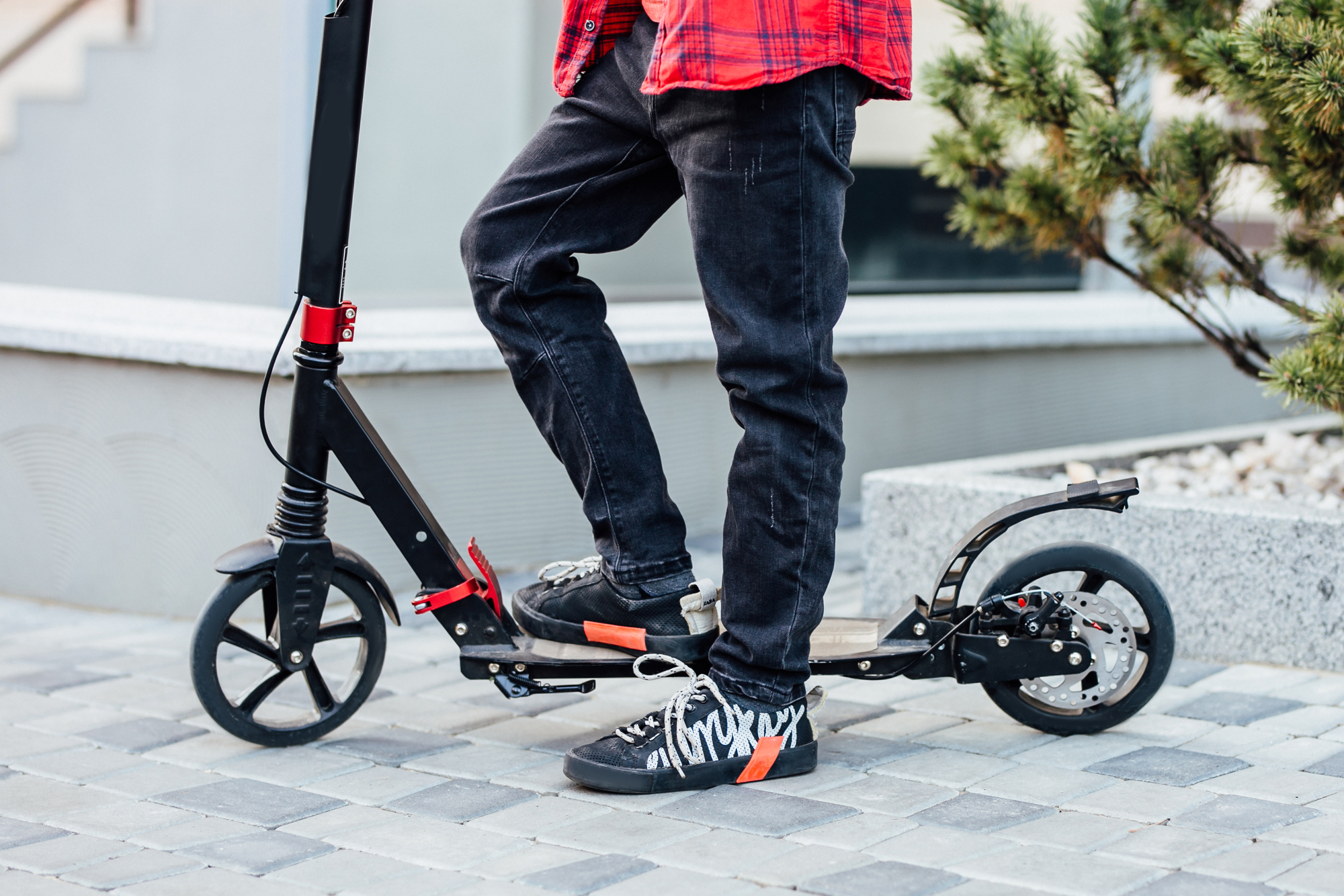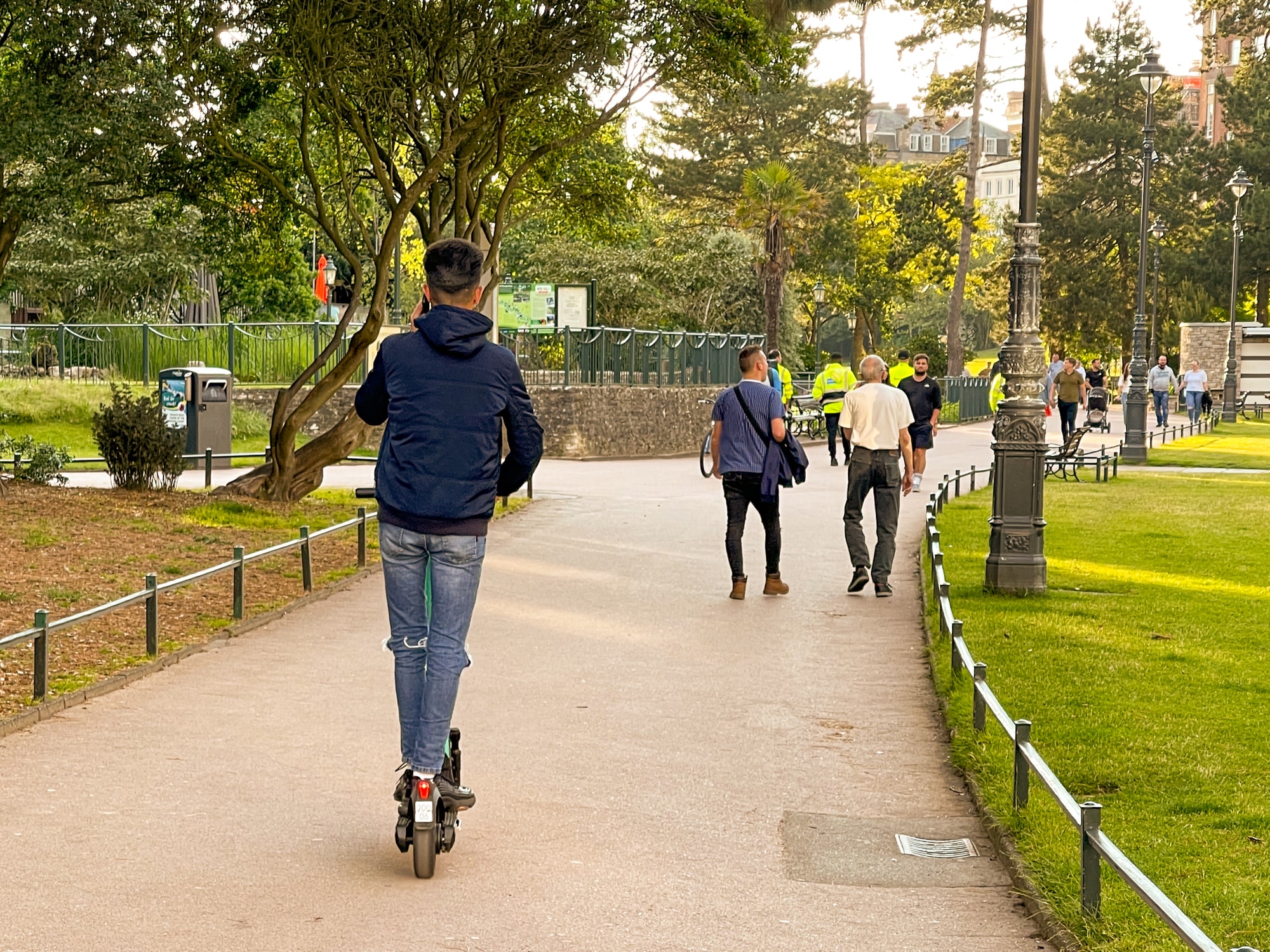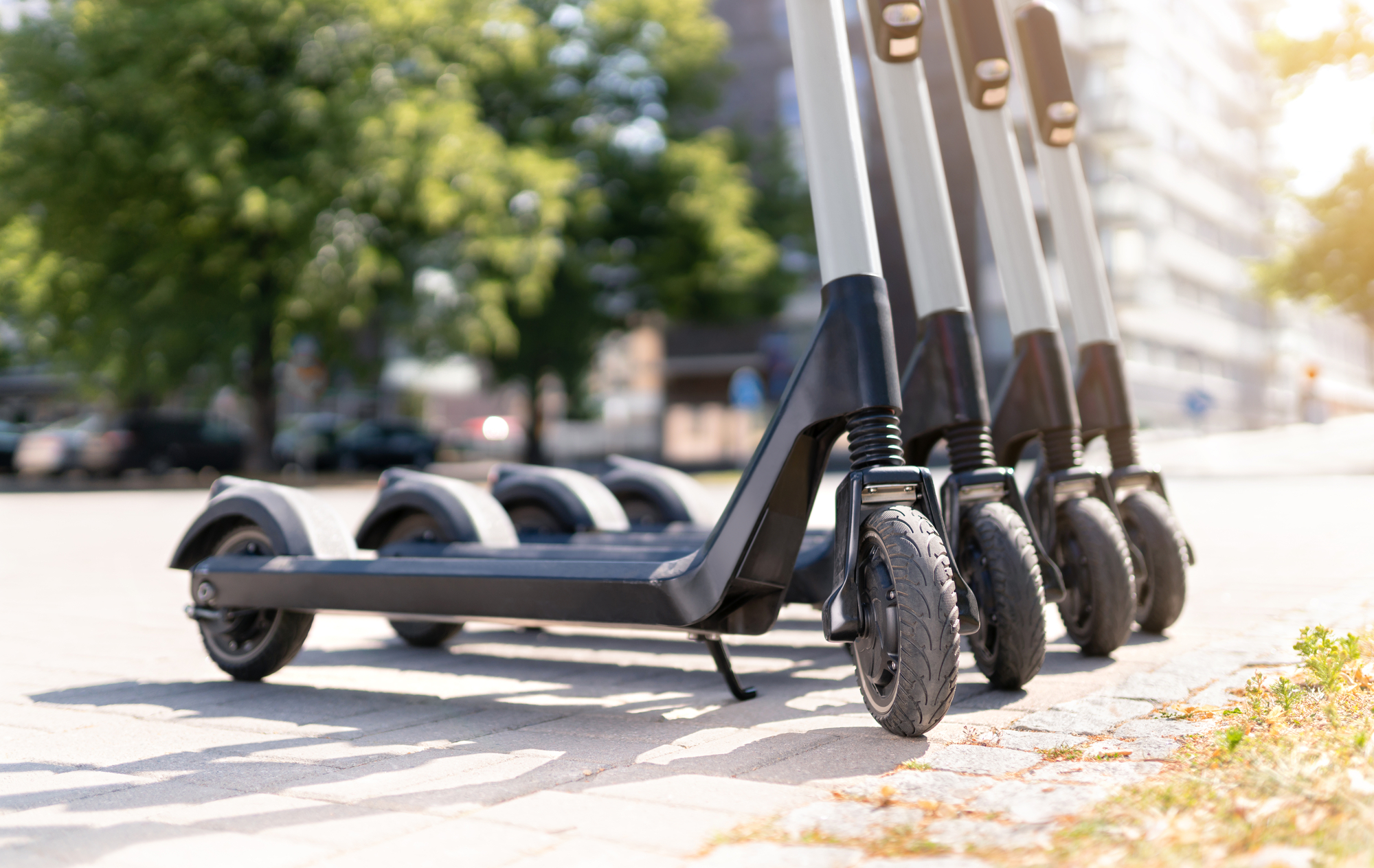Table of Contents
Read on to find more about 18650 and 21700 battery cells regarding their differences, features, and benefits and downsides of their usage in electric scooters.
E-scooters are fitted with batteries which are like the gas tank in automobiles.
They store energy that powers up the motor and other components such as the controllers, display, headlights.
Usually, numerous individual cells are assembled to form a battery pack embedded deep inside the deck or stem of the scooter.
The majority of e-scooters have a battery pack comprising lithium-ion battery cells. However, some inexpensive e-scooters, especially those for kids, are fitted with lead-acid batteries.
18650 and 21700 Batteries Explained

The battery is the most important part of an electric scooter, so understanding what you’re getting with each option is critical if you are trying to get the best value possible.
Here’s the reality… there are benefits and drawbacks to both 18650 and 21700 batteries, so choosing between them requires an in-depth look at how they measure up to one another in various categories.
The chances are that your existing or future e-scooter will likely come equipped with either type of battery, but it’s essential to know the differences.
Lithium-ion batteries are preferred mainly on e-scooters thanks to their ability to deliver a higher capacity output with fewer cells. The vast majority of battery packs for e-scooters comprises 18650 and 21700 cells.
18650 cells were first developed in 1994 by Panasonic and quickly became the preferred standard for electronics across the globe. However, 21700 cells have become the preferred standard in recent years, especially in e-scooters with powerful motors due to their higher capacities and discharge rates.
18650 and 21700 are rechargeable Lithium-ion cells named based on their diameter and length.
18650 cells measure 18mm in diameter and 65mm in length, hence the name 18650, while 21700 batteries measure 21mm in diameter and 70mm in length, hence the name 21700.
Both batteries are available in flat top and button top forms.
However, they are pretty different, even in their physical aspects. 18650 batteries are slightly smaller than 21700 batteries. Being marginally more significant, 21700 batteries store more energy and offer a higher discharge rate than their counterparts.
18650 batteries and 21700 batteries also have different mAh capacities.
mAh’s on 18650 batteries will range from 2000 to 3500, while 21700 batteries have mAh’s ranging between 3000 and 5000. These batteries can be either protected or unprotected.
Protected batteries are integrated with preventive mechanisms (battery management systems) such as overheat protection and PCB, which safeguard against overheating and overcharging. These mechanisms come in handy to make the battery safer for use and also prolong its lifetime.
18650 Batteries
18650 batteries are lithium-ion rechargeable batteries used to power portable electronic devices such as electric scooters.
These batteries are the predecessors of the most recent 21700 batteries, which generally have a higher capacity and discharger rate. However, this doesn’t mean that they are less efficient or can not be used in modern e-scooters.
18650 cells have a diameter of 18 mm and a length of 65 mm. They have a standardised market size of 3.6 and 3.7 volts with a capacity of between 2000mAh and 3500 mAh.
They can store about 10 to 13 Watt-hour (Wh) with such ratings. A 18650 battery marked as 3.7 v 18650 3000mAh means:
- The peak voltage is 3.7v.
- 18650 is the dimensions of the battery.
- 3000mAh is the charge capacity in amp-hours that the battery can provide.
Some phrases can also be added to the battery’s information section, such as “protected mode”, meaning that it’s fitted with an overdraw or overcharge circuit protection and “low self-discharge” to indicate that it can hold a charge in storage.
Protected batteries are integrated with the protective electronic circuit in the battery casing to prevent issues such as overheating and overcharging.
These issues may ruin the charger, and worse even, cause harm to the users through fire incidents and explosions. While unprotected 18650 batteries are cheaper, they are not usually recommended as they can easily overheat, explode or start a fire.
The charge time for 18650 batteries varies based on the specific type of battery and the charger in use.
Usually, it takes about four hours for a 18650 battery to charge fully. Apart from e-scooters, 18650 batteries are used in several gadgets, electronics and accessories, including laptops, high lumen flashlights, vaping devices and more.
What’s the Time Taken to Charge a 18650 Battery
The time a 18650 battery takes to charge depends mainly on its capacity and the type of charger used. As outlined earlier, 18650 batteries have a capacity ranging from 2000 to 3500 mAh.
At maximum capacity, at the 3500 milliamp level (mAh), it takes approximately 4 hours for the battery to charge fully. This charging time may drop to even 3 hours when using a fast charger.
Take note that the charging time varies based on the battery capacity and the type of charger used. What’s more, the charging time increases as the battery gets older. This is also accompanied by a decreased ability to hold a charge.
The time taken to charge the battery and the charge holding capacity are factors that can be used to indicate that the battery is dying.
So, if you notice that your e-scooter takes a longer time than it usually does or it offers fewer miles per charge, it may be time to get a new battery.
18650 Battery LifeSpan
A standard 18650 battery has a lifespan of between 300 to 500 charge cycles. This means they can be recharged from as little as 300 to as many as 500 times before they die. A Lithium-ion battery pack is considered dead when it can no longer hold any charge.
While 500 cycles are the standard lifespan for 18650 batteries, a cell’s lifespan is dependent on several factors such as the frequency of recharging, amount of time they are in use and how they are cared for.
For the most part, the lifetime of an individual 18650 battery is dependent on two main components: the amount of time the scooter is used with energy being drawn from the battery and the number of times the battery is charged. These two factors go hand in hand.
If you frequently ride your e-scooter, then you’ll be charging the battery regularly. Frequent recharging damages the cathode causing the battery to lose its capacity.
Nonetheless, it’s possible to increase the lifespan of a 18650 lithium battery pack through best practices such as preventing the battery from draining completely (deep discharge), removing the battery from the charge immediately it reaches capacity, charging the battery just before use and charging only when it’s below 50%.
Actions such as charging the battery at freezing temperature, overcharging, and under-charging can significantly reduce the battery’s lifespan.
How Much do 18650 Batteries for Electric Scooters Cost?
18650 batteries for e-scooters cost an average of $20-$100.
However, the price is primarily guided by several factors such as the brand, model, quality, capacity and more. Brands such as LG and Samsung are pretty expensive but manufacture the highest quality battery cells.
Pros and Cons of 18650 Batteries
Pros
Some of the benefits of 18650 batteries include:
Good Capacity
18650 batteries have a capacity of between 2000 to 3500 mAh.
This is more than the standard lithium-ion batteries, which range between 800-1200mAh. With such a capacity, 18650 batteries can be linked in either series or parallel to achieve a capacity of up to 10000mAh, which can run powerful scooters.
Small Internal Resistance
18650 batteries have a smaller internal resistance than other batteries, such as nickel-metal hydride batteries. The internal resistance can be less than 35mΩ, thus reducing the self-consumption of the battery cell and consequently prolonging the range of the e-scooter.
Versatile and Efficient
18650 batteries are versatile because they can be connected in both parallel and series to form a battery pack when more voltage is needed.
What’s more, these batteries have a wide range of uses in addition to powering e-scooters. They can be used in laptops, cameras, aircraft components and more. They are also efficient in discharge capacity, which is 100% at 65 degrees.
Convenient for Use
18650 batteries have no memory effect, meaning they don’t necessarily need to be empty before charging.
Besides, they offer higher voltage (3.6V- 4.2V) compared to other types of batteries, nickel-hydrogen and nickel-cadmium batteries. This makes them convenient for use in e-scooters.
Generally Safe
18650 Lithium-ion batteries are generally safe since their negative and positive electrodes are separated.
This dramatically reduces the probability of explosion, burning and short circuit. Most 18650 batteries have the ROHS trademark certification, which implies that they are environmentally friendly (non-toxic and non-polluting).
Always consider protected 18650 batteries as they are not susceptible to overcharging or over-discharging, which significantly decreases their lifespan.
Decent Lifespan
18650 batteries have at least 500 cycles under everyday use. This is pretty decent, considering ordinary batteries have barely half of the 500 cycles.
Downsides
Despite their benefits, 18650 batteries also bear shortcomings, including:
Highly Susceptible to Overcharging/ Overdischarging
18650 batteries are highly susceptible to overcharging and discharging, shortening their lifespan. With time, the performance of these batteries decreases due to such issues.
Fixed Volume
Since they have fixed volume, 18650 batteries cannot be customised to be fixed in another scooter or device. This is unlike other lithium batteries and polymer lithium batteries that are convertible and can be customised in size.
21700 Battery

21700 batteries are rechargeable Lithium-ion cells that are named based on their size, i.e. 21mm in diameter and 70mm in length.
21700 batteries are primarily regarded as an upgrade of the 18650 Li-ion battery since they have higher capacity and power output. These batteries are equipped with hi-drain capacity, ranging from 3000mAh to 5000mAh.
They have a nominal 3.7v and a maximum voltage of 4.2V.
With such a high power-rating, 21700 batteries are mainly used on powerful equipment such as electric scooters, electric cars, electric bikes, vapes, cordless power tools, electric skateboards, electric wheelchairs, personalised equipment and more.
Like 18650 batteries, 21700 lithium-ion batteries are available in two forms: protected and unprotected.
21700 batteries also come in either the flat or button top versions. They are also available in different mAh ranges based on a specific power requirement. Check out the features of 21700 batteries below:
Time Taken to Charge 21700 Batteries
Their charge time depends on the battery’s capacity, which ranges between 3000mAh to 5000mAh, as well as the type of charger you’re using. A 3000mAh 21700 battery, when charged using a 2A charger, takes approximately 1.5-2 hours to charge fully.
The same battery will take up to 4 hours when charged using a 1A charger.
While lower Amps chargers take longer to charge a 21700 battery, they significantly reduce the chances of damaging the battery while it’s being charged.
Therefore, you may want to charge your battery with a slightly lower current, such as a 1A charger, as they will increase the charge cycles of your battery, making them last longer.
21700 Battery Life Span
On average, 21700 batteries last between 3-6 years with about 300 to 500 charge/discharge cycles.
The battery’s lifespan is determined mainly by the frequency of charging and how you take care of it. As the battery is recharged, it degrades due to electrochemical degradation and oxidation.
Poor storage, improper charging, misuse, high constant current load, exposure to high temperatures and humidity, and increased charging frequency are some of the factors that can significantly reduce the life expectancy of a 21700 Lithium-ion battery.
To increase the battery’s lifetime, you’ll want to use the right kind of charger, avoid leaving the battery on the charger for long hours and use only the specified charger, preferably one with lower Amps. These interventions will increase the charge cycles of the battery.
How much do 21700 Batteries for Electric Scooters Cost?
21700 batteries for e-scooters are a bit expensive than 18650 batteries used in electric scooters. Prices start at around $500 and can go as high as $5000 depending on the battery’s rating, brand, and model.
Benefits and Downsides of 21700 Batteries
Pros
Higher Battery Density
21700 batteries have a higher power density compared to other lithium-ion batteries.
For instance, they have a power density of 300Wh/kg, 20% more than 18650 batteries. With such a high power density, 21700 batteries can power up an energy-demanding scooter.
Longer Ranges
21700 batteries offer higher miles per charge compared to other Lithium-ion batteries.
This is due to their higher energy storage capacity. Besides, these batteries enhance a scooter’s energy density since a small number of cells are needed to power the scooter. Improving the scooter’s energy density can cover a more extended range.
Cons of 21700 Batteries
- The biggest downside of 21700 batteries is the lower life cycle due to their large physical size causing an over-discharge of lithium-ions.
- Their large, fixed size also makes them less versatile-they can’t be used across multiple equipment or different scooter models.
- The battery size calls for a larger deck, which reduces portability.
- These batteries are pretty expensive due to their costly manufacturing process and higher material requirement and output capacity.
18650 vs 21700 Batteries- What’s The Difference?

18650 and 21700 batteries have apparent differences in size, energy capacity and more.
While they have some similarities, such as the availability in flat top and button top forms or protected and protected types, their differences set them apart in terms of functionality, efficiency and more. Here are some of their differences.
Physical Size
In terms of physical size, 21700 batteries are a tad larger than 18650 batteries.
The former measures 21mm in diameter and 70mm compared to the latter, which measures 18mm in diameter and 65mm in length. Their difference in regards to size is the basis of their energy capacity and charging time.
Energy Capacity
Considering that they are bigger, 21700 batteries have a higher energy capacity than their 18650 counterparts.
18650 batteries have energy capacity ranging from 2000 to 3500 mAh, while 21700 batteries range from 3000 to 5000mAh. The higher the energy capacity, the longer the miles per charge an e-scooter can cover.
Gravimetric Energy Density
It’s no brainer that 21700 cells have higher energy capacity and discharge rates than 18650 cells simply because they are bigger batteries.
This isn’t comparing them equally due to the size factor. So, to create a fair energy comparison ground, we look at their gravimetric energy density.
Gravimetric energy density is a measurement that relates the energy efficiency with its weight.
It’s essentially a measure of the energy produced by a battery as a ratio of its weight, measured in Watt Hours per Kilogram (Wh/Kg).
In terms of gravimetric energy density, there isn’t much difference between the two battery types. 18650 batteries have a gravimetric energy density of 223 Wh/kg compared to 21700 batteries with a 218 Wh/kg gravimetric density.
Volumetric Energy Density
Volumetric energy density looks at how much energy a battery possesses per its volume.
This measure is used to analyse space efficiency and is denoted in Watt Hours per Liter (Wh/L). 18650 batteries have a Volumetric Energy Density of around 610 Wh/L compared to 590 Wh/L of 21700 batteries.
Verdict
Well, unless physical size matters to you, there isn’t much difference between the two types of batteries in terms of their energy output and efficiency.
21700 batteries are a tad bit modern, but 18650 batteries have undergone significant technological improvement over the years thanks to the growth in electric mobility solutions, including e-scooters.
So, which battery should I choose? The truth is, it all depends on the type of scooter you own. Most modern e-scooters equipped with powerful motors and a long-range requirement will go for 21700 batteries.
This is thanks to the greater power density; but, this also comes with an expected increase in weight and size. For scooters with less power requirements and a focus on portability, then the 18650 variant is better suited for them.
When it comes to cost, recognised brands will always cost more than generic brands, regardless of the batteries, while higher voltage leads to increased cost. But, 21700 will usually cost a little more.
Again, 21700 batteries have higher max output limits than 18650, thus being more versatile in situations requiring high energy output without malfunctioning or overheating.
Most importantly, pick batteries with high safety ratings and from known manufacturers, e.g., Panasonic, LG, Tesla, Samsung, etc., instead of generic brands.
You may also be interested in our article on Lithium-Ion Batteries vs Sealed Lead Acid In Scooters.

